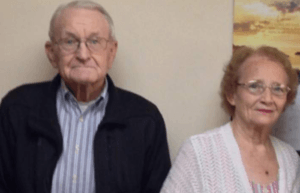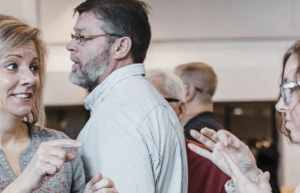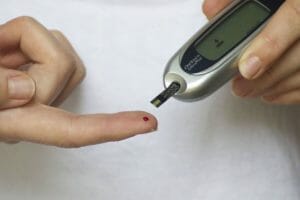
Feast and Fellowship
For 364 days of the year, the showroom at Watertown Ford Chrysler is the stage for polished, new models from the Ford, Lincoln, Chrysler, Dodge, Jeep and Ram lineups. On the 365th day, at least for the past 14 years, the showroom is emptied and transformed into a banquet hall where hundreds of guests dine on a free Thanksgiving dinner.
This year will mark the 15th consecutive year Scott and Jodi Driscoll, members of Lutheran Church of Our Redeemer, will host a Thanksgiving Day feast with all the trimmings at their Watertown, S.D., dealership. Everyone is welcome. And for those unable to travel to the dealership, dinner will be delivered. Hot meals are also catered to those who have to work the holiday at the Watertown Police Department and to county inmates.
The event, which began in 2002, started as a family affair. It’s now a tradition for other families who volunteer to serve in the food line, wait tables and make deliveries.
For the rest of the story, read it at Living Lutheran HERE.
Family Denies Manic-Depressive Disease Is Real
 A member of my extended family reached out to me recently asking me if I believe manic depression is a “real thing.” He knew that I have spent the past seven years reporting on suicide, depression, anxiety and mental health issues.
A member of my extended family reached out to me recently asking me if I believe manic depression is a “real thing.” He knew that I have spent the past seven years reporting on suicide, depression, anxiety and mental health issues.
“Yes, absolutely,” I responded, without hesitation.
He wanted validation he wasn’t getting from his nuclear family.
I’m not an expert in mental health issues, but he was seeking solace from someone who likely would understand. His family, like so many others across the country, denied that mental illness is something real. We are told to “chin up,” “shake it off,” “pull yourself up by your bootstraps” or “you’ll get over it.” The euphemisms are endless.
He was told not to talk about it because “You don’t need your dirty laundry out there for everyone to see.” Few want to admit there might be something “wrong” with a family member, or, heaven forbid, that we be perceived as “weak” or “needing help.”
His mother has told him, “There is no such thing as mental illness.”
How One State Attempts to Reduce Staggering Suicide Rate
In the frontier state of Montana, where kids are taught from a young age to “cowboy up,” suicide has a stranglehold on its people. Residents, many of whom live in isolation, are killing themselves at a rate faster than almost any other place in the nation. Mental health professionals and government officials are scrambling to find a way to halt what has been deemed a crisis.
For nearly four decades, Montana has ranked in the top five states for having the highest rate of suicide, often placing at No. 1. In Big Sky Country, residents young and old alike kill themselves at nearly twice the national average.
For the rest of the story, click here: Rural Health Quarterly
A Father’s Hearing Loss Leads to Isolation, Loneliness
 For my father’s 85th birthday last year, I wanted to surprise him with a phone call. He rarely speaks on the phone because of his hearing loss, but I had convinced myself that his birthday would be different.
For my father’s 85th birthday last year, I wanted to surprise him with a phone call. He rarely speaks on the phone because of his hearing loss, but I had convinced myself that his birthday would be different.
I had planned this for weeks. I would call him at exactly 11:45 a.m. I knew he would be nestled in his favorite easy chair waiting for the noon news, a mere arm’s length from my parents’ telephone in Yankton, S.D.
My heart was pounding as I heard their phone ringing. One ring. Two rings.
My mom answered. “Is Dad there?” I asked.
For the rest of the story, click here: Health Central
Is Climate Change Real? Ask This Alaskan Village
 The idea that climate change is a political issue or a matter of debate makes no sense, said Thomas Richter, pastor of Shishmaref Lutheran, the only congregation in the Alaskan village.
The idea that climate change is a political issue or a matter of debate makes no sense, said Thomas Richter, pastor of Shishmaref Lutheran, the only congregation in the Alaskan village.
“This is not a question that my people struggle with,” Richter said. “We are too busy wondering how we can eat, what we can do with no sea ice, and what will be the future of our way of life. There is nothing political about our homes collapsing into the ocean or the thinness of the sea ice, whose thickness we depend on for food and protection from the storms. There’s just suffering.”
The island, located north of the Bering Strait, is about a quarter-mile wide and 2 1/2 miles long. It’s being gobbled up by flooding and erosion attributed to climate change.
For the rest of the story, click here: Living Lutheran
Diabetes and the Toll it Can Take On Your Feet
Allen Croat said if he had only purchased the proper shoes when first diagnosed with type 2 diabetes 17 years ago, he might have been spared having two toes amputated.
Ten years ago, Croat, 63, had the big toe on his right foot amputated. In December 2016, Croat had the second toe on his right foot severed. He relies on a cane to walk and custom inserts to protect his gnarled feet.
For the rest of the story, click here: HealthCentral.com
How ELCA Churches Reach Out to Deaf Parishioners
As a child, Angela Koterwski would recite her bedtime prayers by mimicking her mother. It was the only time she would pray. While she shadowed her mother’s gestures, the little girl didn’t fully comprehend what she was saying, or why.
She was the only deaf member of her family.
“It was the thing to do,” Koterwski said. “My parents took me to church, but I didn’t get it. I didn’t know God. I didn’t even have a general idea.”
It wasn’t until 2001 when Koterwski and her husband, Mark, who is also deaf, began their lifelong quest to know God. Both were in their 30s. They began attending Peace Lutheran Church in Sioux Falls, S.D., which has four interpreters to minister to the deaf community and also has a deaf Bible study.
For the rest of the story, click here: Living Lutheran

 The
The 

